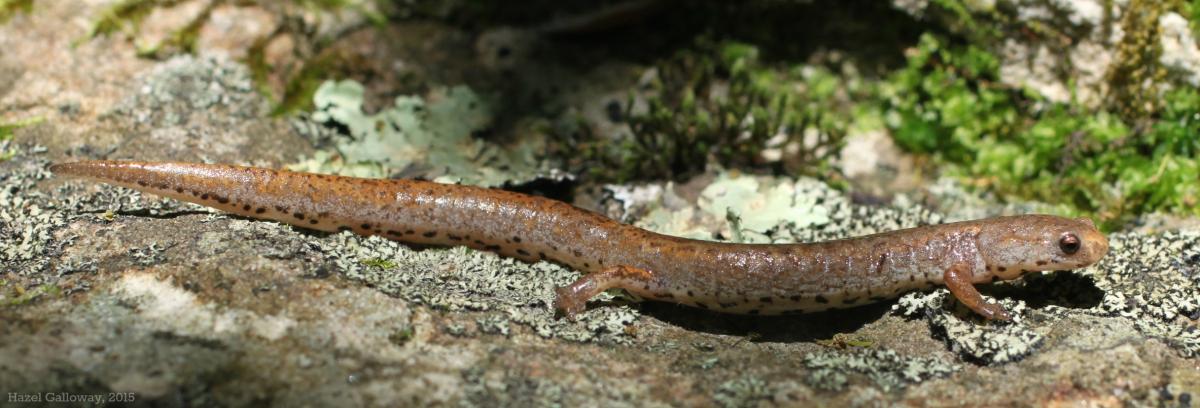Hemidactylium—half-fused-digits—refers to the four toes on the hind legs of this lungless salamander, compared to the five possessed by all other salamanders. Although secretive, highly specialized in their habitat, and lacking social tendencies compared to other plethodontids, they can be found in patches throughout most of the Appalachians.
In addition to its four toes, this species has a unique constricted ring at the base of its tail. Unlike most other species, whose tails do not detach unless grabbed by a predator, four-toed salamanders can detach their tails at will. The tail continues to wriggle after detachment, likely to distract predators. However, in most cases when these salamanders are threatened, their response is to curl up and lie still with their head hidden.
Despite a demonstrated lack of grouping behavior with kin or conspecifics, this species demonstrates complicated mating rituals. After a male approaches a female four-toed salamander and rubs his nose on the female’s, he will walk in circles around her until she climbs onto and straddles his tail. While walking, he then deposits a series of jelly-like globs topped with a yellow spermatophores. For up to 20 minutes, the female will follow after the male, picking the sperm up with her cloaca.
The female then constructs a cavity, typically in a raised clump of moss, to lay up to 80 tiny eggs. Due to a scarcity of good nesting sites, many females may use the same nest; one nest found in Michigan contained 1,110 eggs, suggesting that at least 20 females were involved. One female will normally remain with the nest—although they provide no protection from predators, their presence has been known to increase embryo success, likely through antifungal compounds in the skin of the adults.
Like many other lungless salamanders, four-toed salamanders absorb oxygen through their skin as adults, but have a gilled, aquatic larval stage. They spend just 20-40 days as larvae (compared to 12-15 months in the cave salamander and 2-4 years in the spring salamander); however, by the time they metamorphose into the adult form, they are still only 1.7-2.5 cm in total length. It can take these juveniles 2-3 years to reach sexual maturity; in captivity, they have survived to nine years old.Four-toed salamanders are restricted to forests near boggy areas with sphagnum or vegetation at water’s edge that can serve as nesting sites, although the adults are often found under cover objects in the surrounding forests. Draining of wetlands and loss of vernal ponds and boggy areas due to human activity suggest that populations are likely declining in most areas. Studies done in the George Washington National Forest found that the number of females breeding in vernal pools varies drastically between years, and the species only utilize a subset of apparently similar pools. This unpredictability, combined with adults’ secretiveness and the short larval period, complicates both estimates of population density and any conservation efforts.
Matteo found this individual somewhat anomalously under a log behind the woodshed.
Hazel Galloway
Sources:
- http://animaldiversity.org/accounts/Hemidactylium_scutatum/
- http://srelherp.uga.edu/salamanders/hemscu.htm
- http://www.virginiaherpetologicalsociety.com/amphibians/salamanders/four-toed-salamander/four-toed_salamander.php
- http://www.amphibiaweb.org/cgi/amphib_query?where-genus=Hemidactylium&where-species=scutatum




